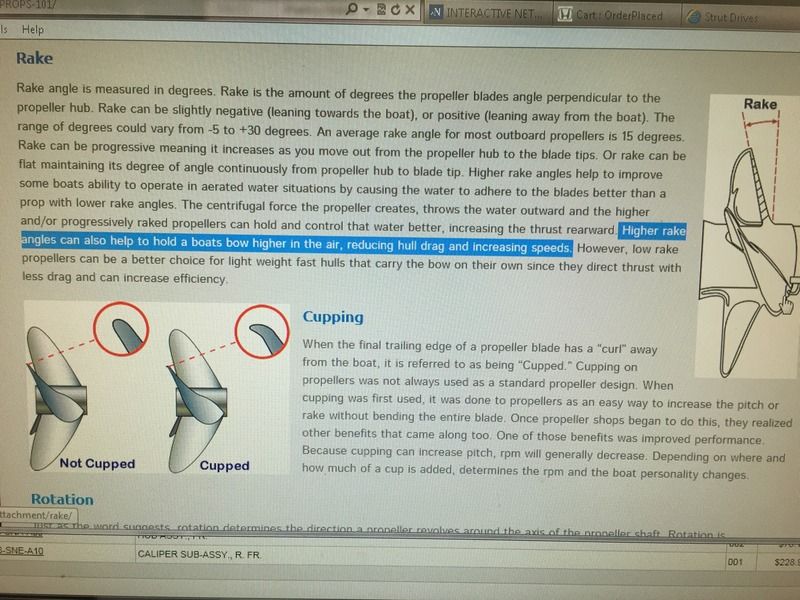How does the rake angle 10 degree versus 17 degree effect the prop. I have been running a H7 on my 21fe jae and was thinking on trying a cleaver style if they would work. I'm running a TP 4050 motor 2200kv 4S was looking for something just for speed passes.
Prop Rake angle
Collapse
This topic is closed.
X
X
-
The higher rake angle will give you more bow lift however....and they are usually a faster prop if you compare to a very similar lower rake angle. This has been my personal experience.32" carbon rivercat single 4s 102mph, 27” mini Rivercat 92mph, kbb34 91mph, jessej micro cat(too fast) wasComment
-
You and I know this, but you have to consider if someone totally inexperienced knows this, I just didn't want to assume. The more info, the better :)
Example. I ran my twin cat this weekend. X442 props. Glued to the water. These have maybe an 8 degree to 10 degree rake at most (I'm just guessing) and then I swapped to 17 degree rake abc props and boy did the nose come up. Was a big difference.Last edited by kfxguy; 10-06-2015, 10:42 AM.32" carbon rivercat single 4s 102mph, 27” mini Rivercat 92mph, kbb34 91mph, jessej micro cat(too fast) wasComment
-
I do have a habit of talking on the puter in short hand LOLYou and I know this, but you have to consider if someone totally inexperienced knows this, I just didn't want to assume. The more info, the better :)
Example. I ran my twin bat this weekend. X442 props. Glued to the water. These have maybe an 8 degree to 10 degree rake at most (I'm just guessing) and then I swapped to 15 degree rake abc props and boy did the nose come up. Was a big difference.Comment
-
Perhaps these images help.See the danger. THEN DO IT ANYWAY!!!
http://forums.offshoreelectrics.com/...hp?albumid=319
http://forums.offshoreelectrics.com/...hp?albumid=320Comment
-
While "bow lift" is how full-scale props are described, not so with models. High lift means transom lift, it's been that way for decades going back to Tom P at Octura. Right or wrong, to bring in the term "bow lift" with model props now just confuses folks and is best forgotten.
.ERROR 403 - This is not the page you are looking for
Comment
-
Well stated. I've seen this wording used here frequently lately, and wanted to say something. Thanks for clarifying this.While "bow lift" is how full-scale props are described, not so with models. High lift means transom lift, it's been that way for decades going back to Tom P at Octura. Right or wrong, to bring in the term "bow lift" with model props now just confuses folks and is best forgotten.
.Darin E. Jordan - Renton, WA
"Self-proclaimed skill-less leader in the hobby."Comment
-
I'll agree with Jay and Darin here. What you refer to as "bow lift" is actually a lack of lift. Your twin cat example is a good one to note. Reverse direction of the props and watch how it changes the lift characteristics of the boat. This will change whether you see the bow or transom lift in your run, but to what degree will be relative to the overall amount of prop lift.You and I know this, but you have to consider if someone totally inexperienced knows this, I just didn't want to assume. The more info, the better :)
Example. I ran my twin cat this weekend. X442 props. Glued to the water. These have maybe an 8 degree to 10 degree rake at most (I'm just guessing) and then I swapped to 17 degree rake abc props and boy did the nose come up. Was a big difference.Comment
-
One thing not mentioned is trim angle effect. If one is running a low rake prop with positive trim to carry the bow it will actually push the stern down and a high rake trimmed negative to hold bow down will actually create some tail lift. Basically wanted to point out props are best when run neutral as they are designed and meant to run. Real boats with power trim you can feel this happen as angles are changed.Comment
-
Really everyone was under this same impression that when lift was talked about,, it meant bow lift !! The older boats used straight steel shaft and were not designed for flex shafts there for needing stern lift to keep there ride level !While "bow lift" is how full-scale props are described, not so with models. High lift means transom lift, it's been that way for decades going back to Tom P at Octura. Right or wrong, to bring in the term "bow lift" with model props now just confuses folks and is best forgotten.
.Comment
-
I'll agree with Jay and Darin here. What you refer to as "bow lift" is actually a lack of lift. Your twin cat example is a good one to note. Reverse direction of the props and watch how it changes the lift characteristics of the boat. This will change whether you see the bow or transom lift in your run, but to what degree will be relative to the overall amount of prop lift.
Whatever you say.....
 32" carbon rivercat single 4s 102mph, 27” mini Rivercat 92mph, kbb34 91mph, jessej micro cat(too fast) was
32" carbon rivercat single 4s 102mph, 27” mini Rivercat 92mph, kbb34 91mph, jessej micro cat(too fast) wasComment
-
Comment
 :canada
:canada
Comment